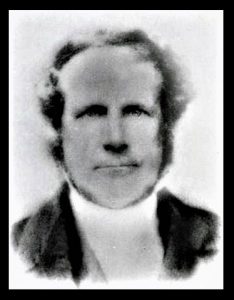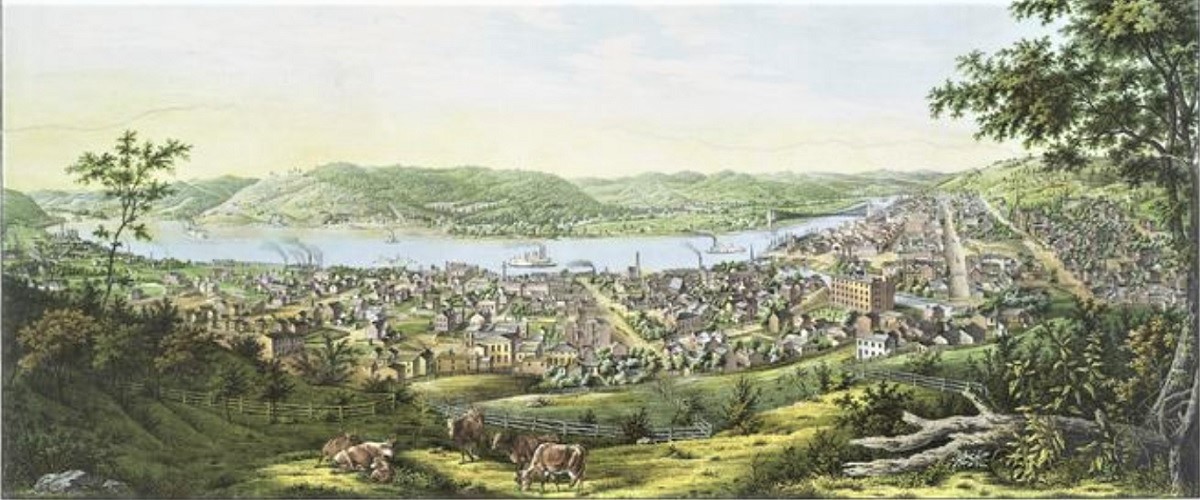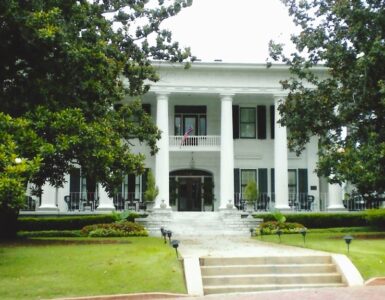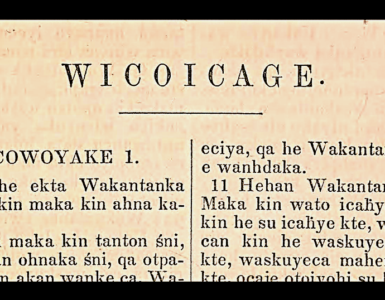 John Work was born November 27, 1807 to Andrew and Mary (Dinsmore) Scott within the parish of the Slate Ridge Presbyterian Church in York County, Pennsylvania. His early education was received under the direction of Pastor James Magraw at Lower West Nottingham Academy with additional studies directed by Andrew Dinsmore, M.D. He graduated Jefferson College in Canonsburg, 1827, then taught school in Butler, followed by Churchville, Maryland, and finally Chanceford, Pennsylvania with the tenure at each only a year. During the time at Butler he professed faith in Christ and began theological studies with Pastor Samuel Martin. Martin’s tutoring prepared Scott to enter Princeton Seminary as a member of the middle class (second year of three). While studying divinity he worked teaching at the Edgehill School. During their early academic years J. Addison Alexander was an instructor at Edgehill and later C. Wistar Hodge would teach there as well. Scott was one of forty students in the class of 1832 that did not complete the full three years of study stipulated by the PCUSA General Assembly. Only eight members of the class completed the requirements, were examined, and granted certificates. It is no wonder that the Assembly was frustrated with the seminary for its willingness to admit new students into the second year, as was Scott, and thereby disregard the three-year requirement. Little if nothing could be done about students who left early, as was the case with William B. Sprague, but admission of new students to a later year could have been more judiciously handled.
John Work was born November 27, 1807 to Andrew and Mary (Dinsmore) Scott within the parish of the Slate Ridge Presbyterian Church in York County, Pennsylvania. His early education was received under the direction of Pastor James Magraw at Lower West Nottingham Academy with additional studies directed by Andrew Dinsmore, M.D. He graduated Jefferson College in Canonsburg, 1827, then taught school in Butler, followed by Churchville, Maryland, and finally Chanceford, Pennsylvania with the tenure at each only a year. During the time at Butler he professed faith in Christ and began theological studies with Pastor Samuel Martin. Martin’s tutoring prepared Scott to enter Princeton Seminary as a member of the middle class (second year of three). While studying divinity he worked teaching at the Edgehill School. During their early academic years J. Addison Alexander was an instructor at Edgehill and later C. Wistar Hodge would teach there as well. Scott was one of forty students in the class of 1832 that did not complete the full three years of study stipulated by the PCUSA General Assembly. Only eight members of the class completed the requirements, were examined, and granted certificates. It is no wonder that the Assembly was frustrated with the seminary for its willingness to admit new students into the second year, as was Scott, and thereby disregard the three-year requirement. Little if nothing could be done about students who left early, as was the case with William B. Sprague, but admission of new students to a later year could have been more judiciously handled.
Leaving the village of Princeton, Scott headed west across the Alleghenies for his first pastoral work. He had been licensed by the Presbytery of New Castle in Delaware, October 3, 1832, and was then ordained and installed by the Presbytery of Hartford on October 3, 1834 the pastor of the church on the commons in Poland, Ohio. Scott had supplied the church for a few brief terms while tutoring in Jefferson College. It appears the Poland call would be his only regular pastoral ministry during his life. In April 1836, Scott moved from the Poland Church to supply the Three Springs Church while assisting ailing Charles C. Beatty in First Church, Steubenville.
Pastoral ministry was not really Scott’s primary interest, nor does it appear his gifts were suited for shepherding a congregation. As was sometimes the case for Presbyterian clergy, pastoral ministry led to work in education. One of his contemporaries was Presbyterian minister William H. McGuffey who became a full-time educator and taught at Miami University in Oxford, Ohio. McGuffey came to be known in his era and later years for numerous editions of his Eclectic Reader. In conjunction with pulpit supply in Steubenville, Scott founded and was principal of the Grove Academy for a decade ending October 1847. He then moved to Wheeling, West Virginia (Virginia, at the time), to be principal of the Lindsley Institute where he served six academic years before returning to Pennsylvania to become president of Washington College. Cortlandt Van Rensselaer delivered the discourse, “Religious Instruction in Colleges,” during the service for Scott’s installation as president and it reflects the controversy among educators concerning the place of religion in education. Even schools like Washington that had been established by Presbyterians or were predominately influenced by Presbyterians were struggling with the relationship of Christianity to higher education. Scott was elected the president of the University of Maryland in 1860 but apparently never served a day in the land-grant institution. One can only speculate without sources for information, but did the growing resistance to clergy in universities lead to the University of Maryland, Scott, or both having second thoughts? However, the increasing tension between North and South could have been the reason given that Maryland was south of the Mason-Dixon Line. Scott continued at Washington until he resigned at the time of its merger with Jefferson College in 1865. Resignation led to his return to West Virginia where in Morgantown he was hired the principal of Woodburn Female Seminary, but then two years later the land-grant Agricultural College of West Virginia (West Virginia University) employed him as its vice president and professor of ancient languages until he transitioned to the professorship of mental and moral science. University vice presidents often find themselves as candidates for the presidency or acting presidents during their tenures (see John McKnight for an example) and Scott found himself acting president for two years. He resigned in 1877 because his vision had deteriorated greatly because of cataracts and he could not do his work.
I became interested in J. W. Scott not because of his ministry or educational work, but because he had cataract surgery. I came upon his brief biography while reading through the Princeton Seminary Necrological Reports and noticed he had successfully received cataract surgery in 1877. It surprised me that eye surgery was done so early in history. How could such a delicate procedure take place just twelve years after the Civil War ended? During the war military surgery was crude—often necessitated by the urgency of manifold casualties—but application of medical knowledge by village physicians or city surgeons under less stressful situations was not much better. Medical science in Scott’s day just did not seem to be sufficient for such a delicate and precise surgery. However, further investigation showed me that crude cataract surgery of limited and temporal efficiency dates to antiquity, with the first truly successful cataract extraction accomplished by the French surgeon Jacques Daviel in 1747. Extraction involves removing the cataract-occluded lens from the cornea. With the experiments of Joseph Lister beginning in 1865 the steps towards controlling the great enemy of any surgery–infection, began and made the likelihood of successful surgery probable. Returning to Scott, what seemed to me to be surgery before its time was in fact a procedure with over a century of medical history. Historical understanding is enhanced when student curiosity is aroused to consider secondary topics that provide a more complete picture of the main subject of study. Sometimes wee ones strain the patience of their parents with their unending chains of questions, but inquiry is the key to the vault of knowledge—after all, question and answer were used for positive purposes by Socrates and the technique of catechesis contributes to training up a child. So, parents, gird up your loins of patience and persevere through all those questions.
Returning to Dr. Scott, unfortunately he did not have long to enjoy his newly restored sight. In the spring of 1879 he moved to Charlotte, North Carolina to become a professor at Biddle University (Johnson C. Smith University). During a vacation Scott died apparently from a heart attack, July 25, 1879.
Scott had married September 20, 1836, Phoebe Anna Jenkins of Windsor Place, Lancaster County, Pennsylvania, who pre-deceased him December 10, 1872. He left three sons and three daughters. He was given the Doctor of Divinity by Washington College in 1852, and the LL D by Washington and Jefferson College, 1865. Scott’s work was not published often, but a few titles are credited to him. One book attributed to him is The Dove: A Parody on “The Raven,” Philadelphia: Published for the Author by Claxton, Remsen & Haffelfinger, 1874. A graduation sermon was provided in the pamphlet titled, The Times, and Signs of the Times. Baccalaureate Sermon, to the Graduating Class of Washington College, August 31, 1862, Washington: Reporter and Tribune Office, 1862. John W. Scott and Cortlandt Van Rensselaer, Addresses and Proceedings at the Inauguration of Rev. John W. Scott, D.D., as President of Washington College, Washington, Pa., Sept. 20th, 1853, Washington: Printed at the Examiner Office, 1853, likely includes the Van Rensselaer discourse noted in my biography of Scott.
Barry Waugh
Notes—The header of Wheeling, West Virginia, viewed from Chapline Hill, circa 1854, is from the NY Public Library Digital Collection. The portrait is from Wikimedia Commons and was located by searching on the site “John W. Scott.” Books used include—History of the Presbytery of Washington, Including a Brief Account of the Planting of the Presbyterian Church in Western Pennsylvania and Parts Adjacent, with Sketches of Pioneer Ministers and Ruling Elders; also Sketches of Later Ministers and Ruling Elders, Philadelphia: Jas. B. Rodgers Printing Co., 1889; Buckeye Presbyterianism: An Account of the Seven Presbyterian Denominations with their Twenty-One Synods and More than Sixty Presbyteries…[etc.], by A Committee of the Synod of Ohio, 1968; Nevin, Presbyterian Encyclopedia; and as was mentioned, Princeton Seminary’s Necrological Report.
.





